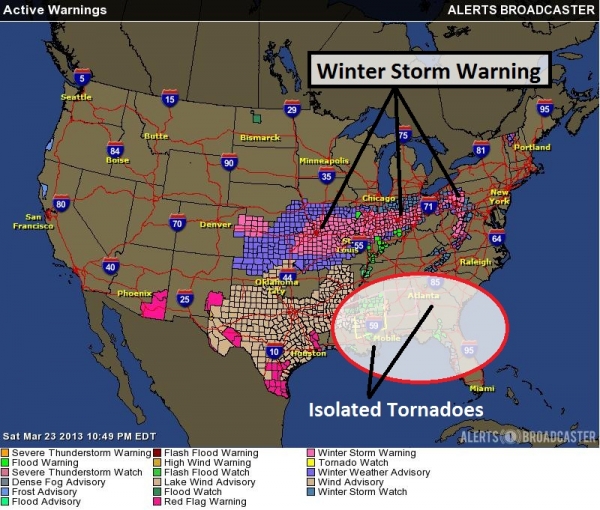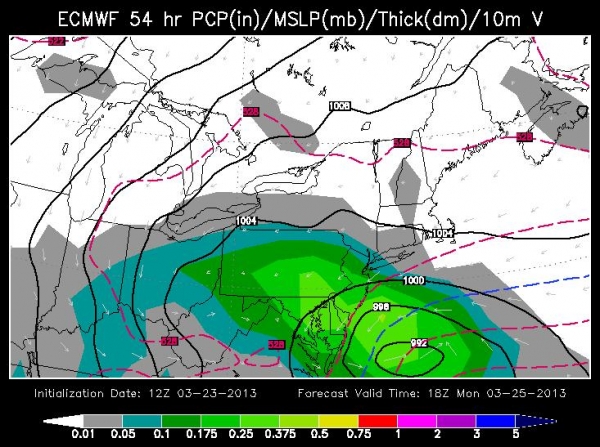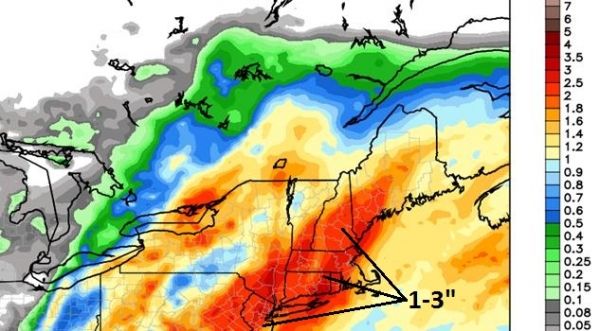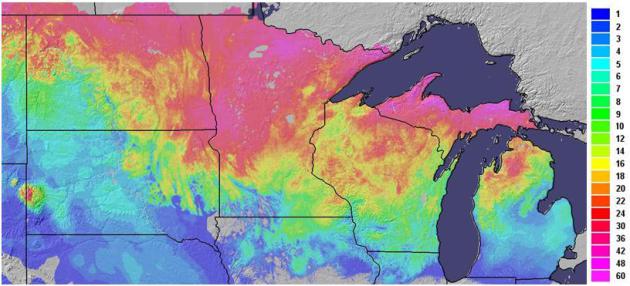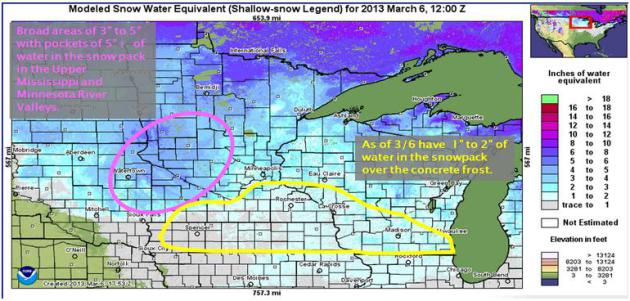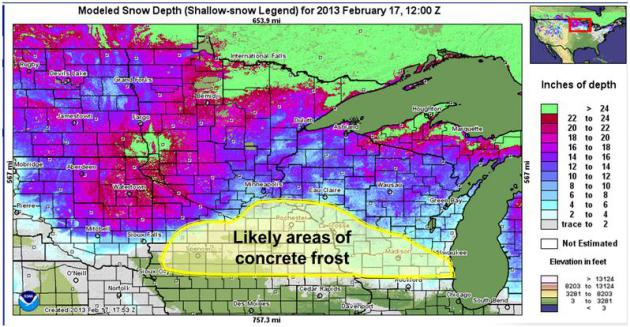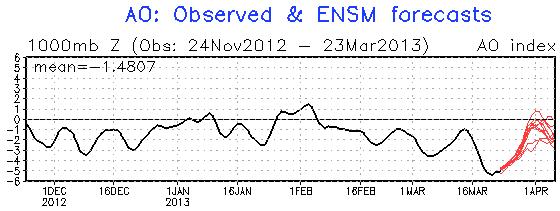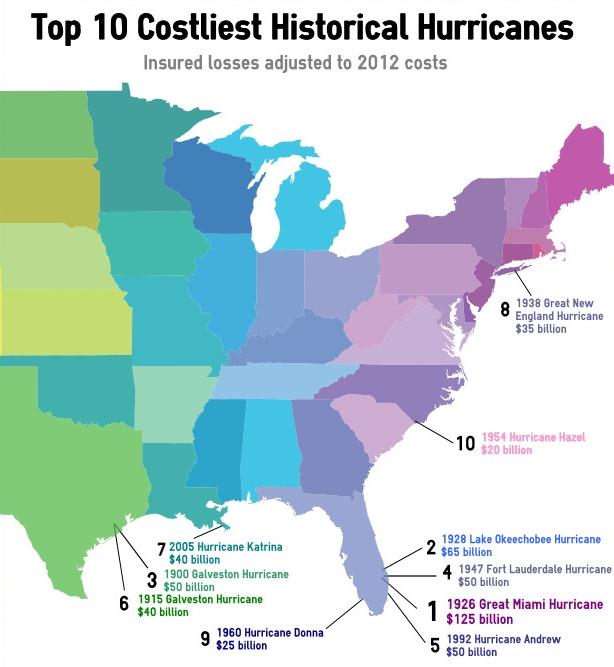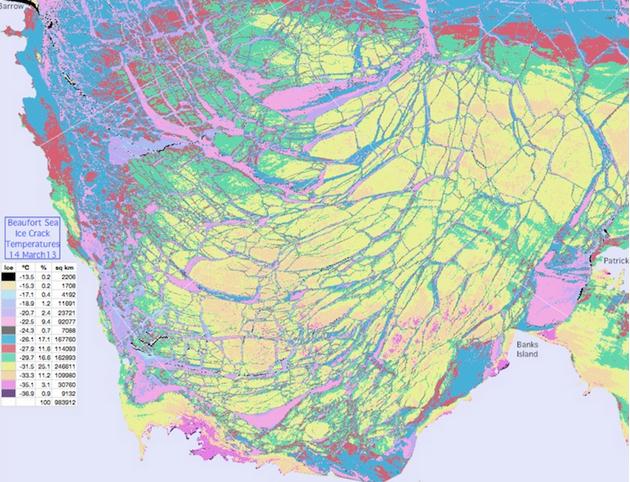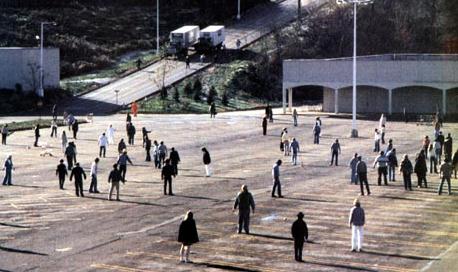Serious Cabin Fever
Yes, we are truly earning our spring this
year. Nearly 50 inches of snow so far; March temperatures 6.5 F colder
than average. Where's our spring break? I don't want to bury the lead:
40F returns by late week. Long-range models show a shot at 50F the first
week of April. 7 inches of snow on the ground will limit how warm it
can get anytime soon, but in roughly 1 week we'll be greeted by gurgling
drain spouts and chirping birds. A tentative spring indeed.
Talk about a surreal weather map: melting snow
may result in flooding on the Red River near Fargo, an area experiencing
severe drought. Until we lose the 15-25 inches of frost in the ground
rain and melting snow will be unable to replenish depleted soil
moisture. That said I'm still optimistic the drought may slowly fade in
the next 2-4 months.
A southern storm brushes the metro with a
coating of slush today; maybe 1" south of MSP. Roads should be mainly
wet. A dry, chilly week is on tap, but moderation is likely next week.
On the blog below: record Arctic ice loss may be
weakening jet stream winds swirling around the polar vortex, allowing
unusually chilly air to reach Minnesota. March AO (Arctic Oscillation)
values haven't been this low since March, 1970!
* Plowable snows likely Sunday and Monday from Kansas City and St.
Louis to Indianapolis and the hills of western
Pennsylvania/Virginia/Maryland.
* Chicago and Detroit should be spared significant snow from this system.
*
Probably warm enough for mostly-rain from Washington D.C. to New York
Monday; 40% risk of accumulating snow Mid Atlantic Region
*
Although I don't expect a widespread tornado outbreak, there is an
elevated risk of hail/damaging winds over the Southeast USA into Monday.
This
situation is more marginal than usual. AB Briefings take into account
a). day of the week extreme weather is expected and b). major population
centers in the path of significant weather. But I want to err on the
side of caution and safety; so here's a quick heads-up on what should
unfold into early next week:
Snowfall Potential.
It still appears the heaviest belt of heavy, wet, slushy snow will set
up from south of Kansas City to St. Louis, Peoria, Indianapolis and
higher terrain of West Virginia and western Virginia, where some 5-10"
amounts are expected. Confidence level is high that much of the Ohio
Valley will get snowed in tomorrow into Monday morning with significant
impact on travel. High water content may result in power outages,
especially suburbs of St. Louis into Indianapolis.
Latest Warnings.
Winter Storm Warnings are posted from the Central Plains into much of
the Ohio Valley, as far east as Pittsburgh, where heavy snow and ice is
imminent. Severe Storm and Tornado Watches are posted for portions of
the southeast. I don't expect a widespread tornado outbreak, but a few
smaller tornadoes are likely into Sunday evening from Birmingham to
Atlanta, Pensacola and Tallahassee.
Sunday Severe Threat.
A slight risk of severe storms from southern Georgia into northern and
central Florida implies hail, high winds, and a few (isolated, smaller)
tornadoes in the orange-shaded area above.
Complex Forecast For Mid Atlantic Region.
The most reliable weather model (ECMWF - European) shows a storm off
the Delmarva Peninsula by midday Monday; a cold rain possibly ending as
wet snow from New Jersey to Wilmington and Baltimore. It looks like a
very close call for wet snow, but the ECMWF is showing just enough warm
air aloft for mostly-rain from this system.
European Snow Solution.
Rather than give you 15 scenarios of what may happen Monday, let me
tell you that right now I'm leaning toward the ECMWF forecast (above),
which shows heavy snow over the Virginia's and upstate New York, but
mainly a cold rain from New York City to Washington D.C. Monday. My
confidence level is low, and if temperatures cool another 1-3 degrees
a plowable snowfall could still result for much of the Mid Atlantic Region, capable of impacting facilities Monday.
Monday Migraine Potential.
Here is the solution that has me mildly paranoid; U.S. models showing
as much as 3-8" of slushy snow from near Baltimore and Annapolis into
south Jersey - most of that snow coming Monday. I still believe the odds
of this verifying are less than 50/50. Another update on Sunday, when
amounts should crystallize.
Summary:
Heavy, wet snow is likely from central Missouri into the Ohio Valley.
Right now it appears Indianapolis will see the most snow, possibly more
than 10". Chicago and Detroit will be spared from this storm. Odds favor
a cold rain much of Monday from Washington D.C. and Philadelphia to New
York City, but there is a 40% risk of accumulating slush, especially
Delaware Valley and southern New Jersey. Severe storms are likely over
the Southeast into early Monday, but right now I do not anticipate a
widespread tornado outbreak. After Monday's storm accelerates out to sea
I expect relatively quiet weather the rest of next week - at least a
7-8 day breather with no heavy snow or major severe storm outbreaks. A
nice change of pace.
March-uary. The calendar says March 24, but the
latest snowcover map looks like something out of late January; more than
16-24" on the ground over much of central and northern Minnesota. Map
courtesy of Ham Weather.
Elevated Risk Of Flooding Due To "Concrete Frost". To be honest, this is the first time I've heard this expression. The
Twin Cities office of The National Weather Service has more details: "
With
the snowfall in February, conditions have changed from below normal
with the January Outlooks to a Normal Risk of Flooding with the February
Outlooks for locations including:
* Montevideo on the Minnesota River
* Granite Falls on the Minnesota River
* Redwood Falls on the Redwood River
* New Ulm on the Cottonwood River
* Long Prairie on the Long Prairie River
* St. Cloud on the Sauk River
* St. Cloud on the Mississippi River
While severe to extreme drought conditions still exist across the
region, precipitation from December 2012 through the first part of
March has been near normal to even above normal in some areas. Hence,
some regions do have a decent snow pack with water equivalents of 3-5".
The graphic (above) shows the amount of water in the snow pack on March
6, 2013.
In addition to the more common river flood threat, this winter parts of Minnesota and Wisconsin have concrete frost. Concrete
Frost is when the top layer of soil becomes saturated and is solidly
froszen. Until it thaws and allows moisture to travel through the soil,
any rain/snow melt will run off similar to how it does on concrete. The image below shows the areas of concern for Concrete Frost and potential quick response flooding."
* A worst-case scenario for flooding would be a rapid rise in
temperature accompanied by heavy rain. This would create massive melting
of snow and possible flash flooding. The extended outlook calls for
mostly 30s and 40s for highs into the first week of April. With any luck
we'll have a nice, gradual, slow-motion thaw.
* The NWS will release their next flood outlook on March 29.
The Winter The Polar Vortex Collapsed. I've noticed an unusually weak polar vortex in recent months, and this article from
The Daily Kos
confirms what I'm seeing. It may be counterintuitive, but our unusually
cold and snowy March may be the result of record ice melt in the
Arctic, and how that's impacting prevailing jet stream winds aloft.
Here's an excerpt: "...
One measure of how contorted the jet stream
has become is by measuring the difference in pressure between the
Icelandic Low and the Azores High. There are two indices used to do
this--one called the Arctic Oscillation (AO), which treats the flow
over the entire Northern Hemisphere, and another called the North
Atlantic Oscillation (NAO), which is more focused on the North
Atlantic. The two are closely related about 90% of the time. When these
indices are strongly negative, the pressure difference between the
Icelandic Low and the Azores High is low. This
results in a weaker jet stream, allowing it to take large, meandering
loops, letting cold air to spill far to the south from the Arctic into
the mid-latitudes. The AO index hit -5.2 today (March 20). This
is the second most extreme March value of the index since record
keeping began in 1948; only an AO value of -6.3 in March 1970 was more
extreme."
Arctic Oscillation. To make a long weather story
mercifully short, the more negative the AO (Arctic Oscillation) the
lighter the prevailing westerly winds are blowing at high latitudes.
Weaker wind speeds increase the potential for bitter air to push south
into the USA, which is exactly what's been happening this month. When
will we crawl out of this cold rut?
AO Prediction. NOAA shows the Arctic Oscillation
becoming (less) negative in the next 10 days, which should mean a slight
moderation in temperatures. Yes, 40s will be a dream come true huh?
Sandy Set To Be 3rd Costliest Hurricane, But Storms Of The Past Offer Perspective. Let's pray we don't have a 1926/Miami-size hurricane again anytime soon. Some timely numbers and perspective from
PropertyCasualty360: "
Superstorm
Sandy will likely become the third-costliest hurricane in U.S.
insurance history, but when examining historical storms using today’s
dollars and exposures, Sandy would fall to the 12th costliest storm,
says the Insurance Information Institute. In a presentation posted on
I.I.I.’s website, initially given at Midwestern Actuarial Forum in
Chicago today, I.I.I. Chief Economist Steve Weisbart projected Sandy
insured losses to hit $20 billion, based on estimates of
catastrophe-modeling firms and reported losses as of Jan. 12. That
would place Sandy behind 1992’s Hurricane Andrew ($25.6 billion in
insured losses) and ahead of 2008’s Hurricane Ike ($13.4 billion). All
of those storms are dwarfed by 2005’s Katrina ($48.8 billion)..."
Graphic above (adjusted for inflation) courtesy of Karen Clark & Co.
Why Music Helps You Exercise Better. This article at
Lifehacker caught my eye yesterday; here's a snippet: "...
Music
distracts people from pain and fatigue, elevates mood, increases
endurance, reduces perceived effort and may even promote metabolic
efficiency. When listening to music, people run farther, bike longer and
swim faster than usual-often without realizing it. In a 2012 review of
the research, Costas Karageorghis of Brunel University in London, one
of the world's leading experts on the psychology of exercise music,
wrote that one could think of music as "a type of legal
performance-enhancing drug..."
We Now Live In A World Where More People Have Mobile Phones Than Clean Water. This headline made me do a triple-take; here's an excerpt from
Quartz: "
It
is World Water Day, and time for the United Nations to remind us how
many people in developing countries still lack basic sanitation.
Surprisingly, the UN reports
there are now more people with mobile phones (six billion for world
population of seven billion) on earth than there are with access to
clean toilets (4.5 billion). That phenomenon is easily visible in
Indonesia, for example, where it is common to see people who live in
metal roofed shacks without bathrooms surfing Facebook on their
smartphones or feature phones.
And it shows how, in the developing world, multinationals are often
better at responding to peoples’ needs than governments are..."
Bucket List. My wife and I just returned from New
Zealand, where we hosted a tour. Imagine a mash-up of Hawaii,
Switzerland and England (with no chain stores). It's an amazing country;
a little tough to get to - 14 hours from L.A. to Auckland, but worth
the effort. The photo above was taken from our hotel in Queenstown, on
the Southern Island, which has mountains, majestic lakes and fiords
(like Norway). I'm starting to sound like a travel agent. Sorry. Here's
the thing. I have a lot of older friends and family members who waited
until their golden years to travel and do all the things they wanted to
do together - only to be confronted with serious health issues that made
travel impossible. So we've decided to take a few time-outs and see as
much of the world as we can now. The best part of experiencing other
countries and seeing how the rest of the world lives? Coming back to
Minnesota. Yeah, even this month.
39 F. high on Saturday in the Twin Cities.
45 F. average high on March 23.
73 F. high on March 23, 2012. Ugh.
7" snow on the ground.
13.8" snow so far in March at KMSP.
1.3" snow in March, 2012.
A Case Of The Chills. Hey, we were only 6 degrees
cooler than average yesterday. Highs were in the 30s statewide.
International Falls woke up to a crisp -2F, with a whopping 28" of snow
on the ground. Are you sure it's spring? I'm starting to wonder.
Climate Stories....
Ice Breaking News: This Is Your 2013 Arctic Freezing Season On Crack. Here's a snippet of a story from Arctic Sea Ice Blog and
ThinkProgress: "
The
sea ice cap on top of the Arctic Ocean is often imagined to be a
monolithic, continuous sheet of ice floating on water. A closer look
quickly shows it is rather a collection of larger and smaller pieces of
sea ice. Of course, we have all seen the images
of ice floes separated by open water during summer, but even during
winter the ice pack gets fractured, leading to leads that quickly freeze
over again..."
Graphic credit above: "
Image of massive Arctic sea ice cracks showing temperature of the ice and the cracks between floes." Via
Arctic Sea Ice blog.
U.N. Chief Warns That Nearly Half The World Could Face A Scarcity Of Water By 2030. Here's an excerpt from
The Washington Post: "
Secretary-General
Ban Ki-moon is warning that by 2030 nearly half the world’s population
could be facing a scarcity of water, with demand outstripping supply
by 40 percent. Ban said one in three people already live in a country
with moderate to high water stress. He spoke Friday at a U.N. event
marking the opening of the International Year of Water Cooperation 2013
and the 20th anniversary of the proclamation of World Water Day..."
Climate Changes Before I Retire. This Op-Ed in the
Vancouver Observer resonated with me - here's an excerpt: "
There’s
not a lot about climate change and its effects that horrifies me
anymore. I guess you could say that I’m desensitised to it – melting
permafrost? Yeah, I’ve read about it. Losing the Great Barrier Reef in
Australia? Going to visit it before it’s all gone, but yeah, we’ll lose
that too. A friend is buying a house? I’m cracking the jokes about how
high above sea level it is and whether we’ll need to fortify it for the
‘end of the world’. Most of the research that is coming out now
looking at climate models and the potential feedbacks we may get from
complex climate systems are thinking we may have underestimated
how fast climate change is going to kick us in the ass. If we’re
lucky, and none of the non-linear feedbacks kick in too fast, we’re
looking at experiencing between 1-3 C of global warming by 2050, and
it’s likely those estimates will be conservative..."
Graphic credit above: "
Warming projections to 2080 from Rowlands et al. in Nature Geoscience 5, 256-260 (2012)."
Geoengineering Is A Dangerous Solution To Climate Change.
I have my doubts that there's a simple "fix" to counterbalance the
trillions of tons of warming greenhouse gases we've pumped into the
atmosphere. Should we keep an open mind? Absolutely. Is it going to be
easy? I doubt it. Here's an excerpt of an Op-Ed at
Huffington Post: "
As
the realities of global climate change become ever more alarming,
advocates of technological approaches to "geoengineer" the planet's
climate are gaining a following. But the technologies that are promoted
-- from spraying sulphate particles into the stratosphere, to dumping
iron particles into the ocean, to stimulate carbon absorbing plankton,
to burning millions of trees and burying the char in soils -- are all
fraught with clear and obvious risks, and are most likely only going to
make matters worse. Yet zeal for these approaches continues unabated.
According to right-wing think tank American Enterprise Institute, geoengineering offers:
"...the marriage of capitalism and climate
remediation...What if corporations shoulder more costs and lead the
technological charge, all for a huge potential payoff?...Let's hope we
are unleashing enlightened capitalist forces that just might drive the
kind of technological innovation necessary to genuinely tackle climate
change."
What Zombie Films Tell Us About Climate Change: There's No One Happy Ending.
What does climate change (and the notion of a 'safe' 2 degree C.
warming limit) have to do with zombies? Here's a segment of an
interesting Op-Ed at
The Guardian: "...
Stories
generally have three elements; a thesis (the existing order), the
anti-thesis (the thing that threatens to disturb that order) and the
synthesis (the new order that emerges after the threat has been dealt
with). That is what gives a story its narrative arc and tension. The
great thing about proper zombie films is that they play havoc with this
structure. There is a thesis and an anti-thesis but no synthesis. The
zombies are never destroyed and no new stable order emerges. And that, I
fear, may be the truth of the climate change story...."
Photo credit above: "
In zombie movies such as Dawn of the
Dead, 'zombies are never destroyed and no new stable order emerges. And
that, I fear, may be the truth of the climate change story'. Photograph: Ronald Grant Archive.


